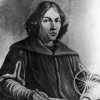Nicolaus Copernicus

Nicolaus Copernicus
Nicolaus Copernicus; German: Nikolaus Kopernikus; 19 February 1473 – 24 May 1543) was a Renaissance mathematician and astronomer who formulated a model of the universe that placed the Sun rather than the Earth at the center of the universe. The publication of this model in his book De revolutionibus orbium coelestiumjust before his death in 1543 is considered a major event in the history of science, triggering the Copernican Revolution and making an important contribution to the Scientific Revolution...
NationalityPolish
ProfessionScientist
Date of Birth19 February 1473
CountryPoland